|
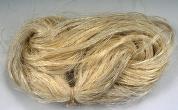
Raw Silk

"How to Use Florence Knitting Silk"
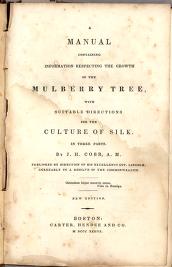
"A Manual Containing Information Respecting the Growth of the Mulberry Tree, with Suitable Directions for the Culture of Silk"
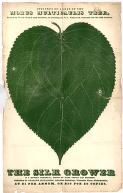
"Specimen of a Leaf of the Morus Multicaulis Tree for The Silk Grower"
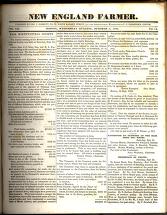
"Manufacture of Silk Not New in New England" from New England Farmer

"Culture of Silk" from New England Farmer
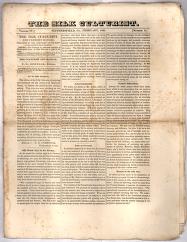
"The Silk Culturist"
|
Summary and Objective
Local industries or sites may be of use to students in learning about their own communities and their part in history as a whole. For my lesson, I took advantage of the former silk industry in Leeds and Florence, Massachusetts. By examining local landmarks and a variety of documents that illustrate the importance of silkworms and mulberry trees in promoting industry, students will understand that silk was an important part of their local economy for a century. Students will also gain a better understanding of the complexities involved in maintaining a successful industry.
Teaching Plan
Step 1.
Choose a site or landmark with local significance (e.g. historic home, industrial site, area where an important event occurred) and plan a field trip there. Encourage students to look carefully at the site to notice details and surroundings. My students and I will take a walking field trip to the nearby site of the former Nonotuck Silk Company. After observing a brick mill building carefully, students will draw its interesting architectural features using paper and clipboards. During our walk, students will also notice the important aspects of the surrounding landscape (Mill River, bridge, old railroad path) and the nearby mansion and mill housing, and consider possible uses for the buildings.
Step 2.
After the field trip, hold a class discussion regarding students' predictions about the significance of the landmark or area, and chart observations and ideas. After discerning that the large brick building my class observed functioned as part of a mill (and noting significant details like: the small homes of the mill workers; the large mansion which belonged to the factory owner; the powerful force of the river; the reason for the railroad and transportation of goods, etc.), I will ask for guesses as to what was made there.
Step 3.
Before revealing the answer, teachers should provide authentic clues by using real objects or images related to the site visit. In my case, I will show the image of raw silk and ask children to identify what it is. Next, I will pass around a piece of silk for children to feel and reveal that silk was made at the site we visited. The vocabulary words "producers" and "consumers" will be emphasized to provide a framework for understanding this local industry.
Step 4.
Teachers should consult with local historical societies, libraries, or state agencies for information on available resources and images relevant to their chosen local sites. For my activity, I will share the front and back cover images of the advertisement "How To Use Florence Knitting Silk." After noticing the name of our town and the silk stockings on the cover, we will examine the back for important information on how silk was produced and what natural resources were necessary. Children will most likely be familiar with the concept of a moth's life cycle, and may recognize the stages illustrated on the pamphlet cover.
Step 5.
Provide a variety of documents and real or digital objects to share with students in small groups, who will then report back to the larger group what they examined and how they think it relates to the landmark being studied. For instance, the documents shown here feature pictures of mulberry leaves and directions on the successful growing of these trees. This information will help students understand that mulberry trees were the only viable food for the silkworms who produced the valuable silken threads and therefore, very important to the success of the industry.
Step 6.
Provide guidance to students in learning to look at and interpret primary source documents. Help them summarize what they notice and ask them to report their conclusions to the class. In my activity, children will examine several documents pertaining to the silkworm and read about the complicated steps necessary to navigate the stages of growth. Children will write down a fact or two to share with the class regarding care of the silkworms and share their conclusions about the ease or difficulty of raising them.
Step 7.
As a final step, teachers should brainstorm with students what they have seen and learned from studying their significant local building, industry or home. I will ask students whether silk is still being produced in Northampton. After determining it is not, we will discuss possible reasons for the demise of the local industry. Cold weather, the high cost of mulberry trees, the mulberry tree blight in 1844, and a change in fashion trends all played a role. These will be charted using a graphic organizer.
|




